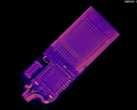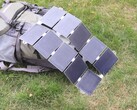After ESA, together with various European partners, demonstrated in a feasibility study that the construction of a satellite-based telephone network is not only technically feasible, but also relatively inexpensive, practical proof has just been provided: A test connection to a satellite equipped with standardized 5G technology remained stable during its visibility over the location of the receiver. This is remarkable in two respects.
The LEO 3 satellite, a research satellite launched into low earth orbit purely for demonstration purposes, hovers just under 1,000 km above the earth's surface. If you include the frequently oblique angle (as the satellite travels further away from the receiver), the distance is up to 2,000 km or more, which poses several challenges for antenna technology.
The second point: in order for the satellite to remain in orbit, it has to travel at around 28,000 km/h, which makes maintaining 5G over the entire visible circular segment of its orbit anything but easy.
Previous tests have thus only been carried out with geostationary satellites whose position above the earth's surface is reliable. The only problem is that 5G or any other connection with as little latency as possible cannot be implemented in this way.
Large distances, high latencies
Such satellites are located at an altitude of 36,000 km. If you add the respective angle, this quickly becomes more than 50,000 km. For this distance, which also has to be covered twice, even light needs just under a third of a second. Far too much for real-time applications.
Following the successful first test, real-time applications are now within reach, partly because a stable connection was achieved on a normal frequency band using established technology. According to the ESA, the specifications of 3GPP, a standardization committee for mobile communications, were met.
This paves the way for mobile communications that do not require any additional technology on the ground, and represents an important innovation for regions that are difficult to reach, for crisis areas and for communication channels that require special protection. The ESA has already announced major practical tests for 2025.


















